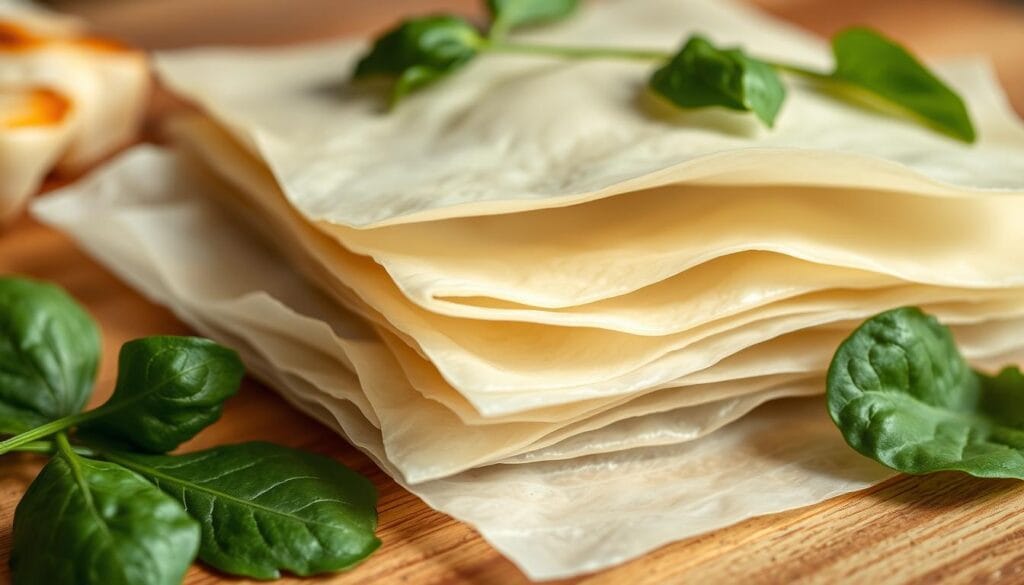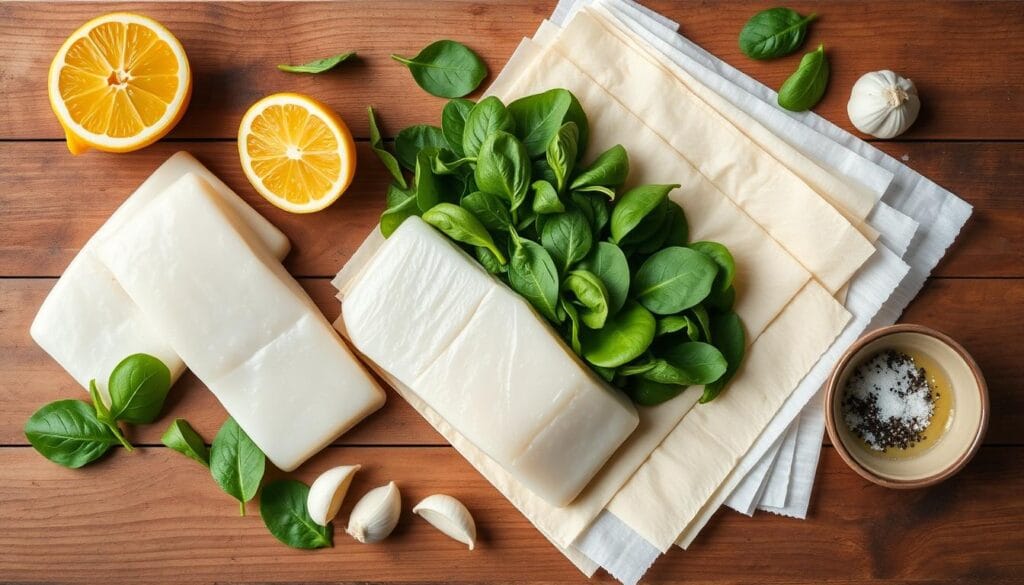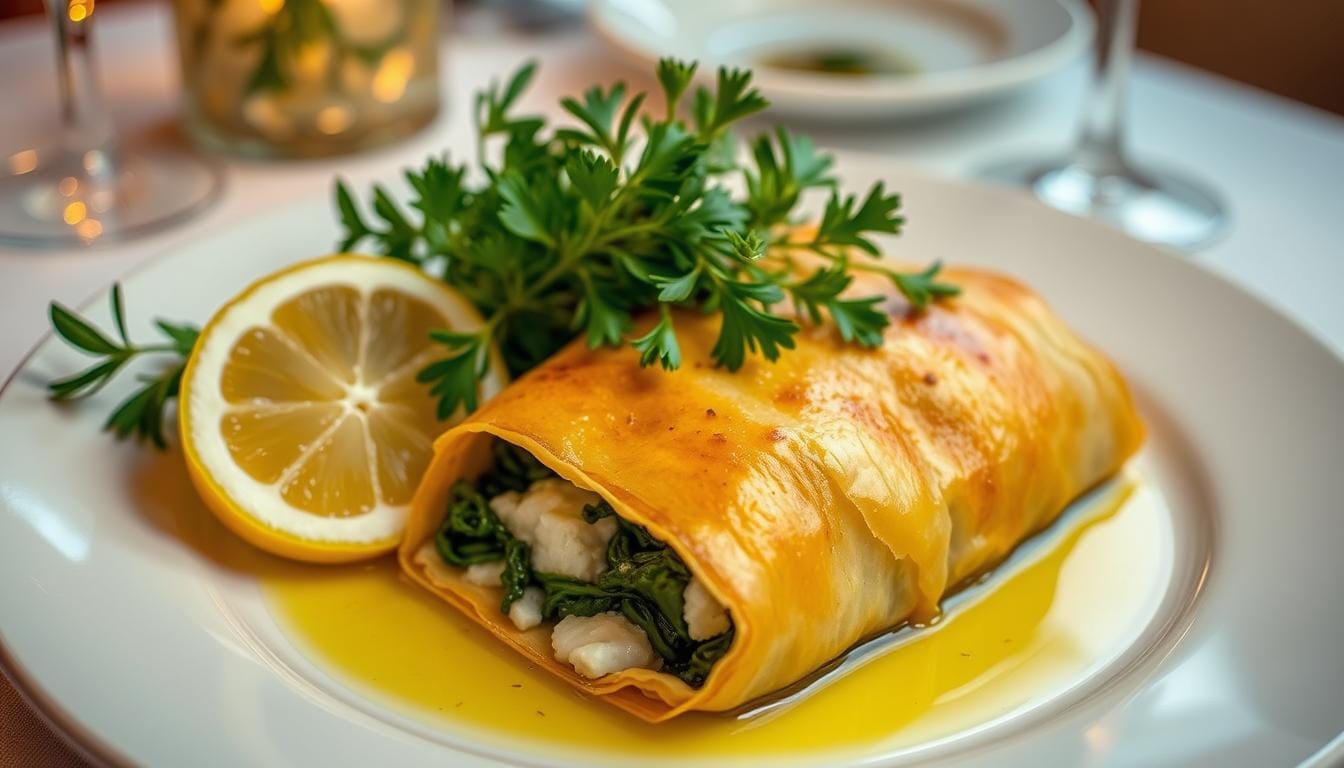Ever wondered how chefs turn simple ingredients into a masterpiece? The halibut and spinach wrapped in filo recipe is your ticket to dining like a pro at home.
Phyllo dough has changed the game in international cooking. It brings flavors from Greece, the Middle East, and the Mediterranean right to your plate. Home cooks love it, with 85% saying it makes their meals more satisfying.
Making a halibut and spinach wrapped in filo recipe is more than cooking. It’s about taking your guests on a taste journey. Seafood fans will love the 75% who prefer fish dishes, made even better with this technique.
Picture wowing your guests with a dish that’s both fancy and tasty. The flaky phyllo, the rich halibut, and the spinach all come together. This recipe is more than food; it’s an adventure that turns simple ingredients into a memorable meal.
Understanding Filo Dough: A Flaky Foundation
Filo dough is a culinary wonder that turns simple dishes into amazing experiences. If you’ve ever wondered if there’s a difference between filo and phyllo, you’re not alone. In fact, filo and phyllo are the same thing, just different spellings of the same thin pastry.

Filo is known for its very thin, paper-like texture. Unlike regular pastry dough, filo sheets are light and delicate. They need a gentle touch and special handling.
Unique Characteristics of Filo
- Extremely thin layers (almost translucent)
- Creates crispy, flaky texture when baked
- Typically made from flour, water, and a small amount of oil
- Versatile for both sweet and savory dishes
Working with Filo Sheets
Mastering filo takes patience and practice. The trick is to keep the sheets moist and covered to avoid cracking. Chefs suggest using a damp towel to cover unused sheets, keeping them soft and easy to work with.
Storage and Handling Tips
- Keep filo refrigerated until ready to use
- Thaw frozen filo in the refrigerator overnight
- Work quickly and gently when handling sheets
- Brush each layer with melted butter or oil for extra crispiness
“Filo is not just a pastry, it’s an art form that requires respect and technique.” – Culinary Expert
Essential Ingredients for Halibut and Spinach in Filo

Starting with the best ingredients is key to a great halibut and spinach filo dish. Knowing how many layers of phyllo dough to use is important. It helps get that perfect crispy texture that makes the dish stand out.
Your main ingredients will turn a simple meal into a work of art:
- Fresh Halibut Fillets: Pick high-quality, firm white fish with a mild, sweet taste
- Baby Spinach: Fresh, packed with nutrients, and pairs well with the fish
- Phyllo Dough: Thin pastry sheets that make crispy layers
- Olive Oil: Adds healthy fats and boosts flavor
- Seasonings: Use kosher salt and black pepper to enhance taste
Experts say to use 8 sheets of phyllo dough for the best crispiness. This makes the outside golden and flaky, wrapping your filling nicely.
“The secret to perfect filo is in the layers and technique” – Culinary Expert
Remember, squeeze out spinach moisture to avoid soggy filo. Aim for a crisp, delightful texture that will wow everyone.
Preparing Your Halibut for Perfect Results
Making a great halibut dish starts with knowing how to prepare it. You need to pick the right fish, season it well, and manage its moisture. These steps can turn a simple fish into a culinary work of art.
Selecting Fresh Halibut
When picking halibut, look for these signs of freshness:
- Firm, translucent flesh with no discoloration
- Mild ocean-like scent
- Average fillet weight of 6 oz.
- Thickness around 1 inch
Proper Seasoning Techniques
To boost your halibut’s flavor, use a smart seasoning plan. The goal is to add to the fish’s taste without overpowering it.
| Seasoning | Quantity | Purpose |
|---|---|---|
| Sea Salt | ¾ teaspoon | Enhances natural flavors |
| Black Pepper | ¼ teaspoon | Adds subtle heat |
| Nutmeg | Pinch | Provides depth |
| Cayenne | Small pinch | Creates complexity |
Moisture Control Methods
Should you soak halibut before cooking? It depends on your cooking method. For this recipe, soaking isn’t needed if you follow these tips:
- Pat the halibut dry with paper towels
- Season immediately before cooking
- Use a light marinade with 2 tablespoons olive oil
- Add 1 teaspoon lemon zest for brightness
“The key to perfect halibut is respecting its delicate nature and treating it with culinary precision.”
By following these steps, you’ll make a halibut dish that’s moist, flavorful, and perfectly cooked every time.
Spinach Preparation and Seasoning Guide
Getting your spinach ready for the halibut and spinach wrapped in filo recipe is key. Fresh spinach can make your dish go from good to amazing. It changes the whole taste experience.
Here are the important steps to prepare spinach for your recipe:
- Select fresh, vibrant green baby spinach leaves
- Thoroughly wash spinach to remove any dirt or debris
- Drain excess moisture completely to prevent soggy filo
- Chop spinach into uniform, bite-sized pieces
Pro tip: Pat spinach dry with paper towels to ensure optimal moisture removal.
Seasoning is vital for a balanced flavor. Here are some seasonings you should use:
- 1 teaspoon salt (divided)
- 1 teaspoon black pepper
- 1 teaspoon lemon zest for brightness
- Optional: Garlic powder or fresh minced garlic
“The secret to perfect spinach is in its preparation and subtle seasoning.”
When mixing spinach with halibut, add 4 ounces of whipped cream cheese. This makes a creamy filling that goes well with the fish. It makes your halibut and spinach wrapped in filo recipe a hit with everyone.
Halibut and Spinach Wrapped in Filo Recipe
Discover a quick 15-minute culinary masterpiece that transforms halibut into an elegant dinner. This recipe solves the common challenge of how do you keep phyllo shells from getting soggy by using precise techniques and careful preparation.
Ingredient Measurements
To create the perfect halibut and spinach filo wrap, gather these key ingredients:
- 8 ounces fresh baby spinach
- 4 ounces cream cheese
- 2 tablespoons parmesan cheese
- 1 tablespoon unsalted butter
- 1 large egg (mixed with 1 teaspoon water for egg wash)
- Filo pastry sheets
- Fresh halibut fillet
Step-by-Step Assembly
Preventing soggy phyllo shells requires careful handling. Follow these steps to ensure crispy, flaky perfection:
- Pat halibut dry with paper towels to remove excess moisture
- Sauté spinach until completely wilted and drain excess liquid
- Mix cream cheese and parmesan with cooled spinach
- Layer filo sheets, brushing lightly with melted butter between each layer
- Place halibut and spinach mixture carefully on prepared filo
- Fold edges to create a sealed packet
Cooking Temperature and Timing
To keep your phyllo crisp and halibut perfectly cooked, use these precise instructions:
- Preheat oven to 425°F
- Bake for 25-30 minutes
- Brush with egg wash before baking for golden color
- Check internal fish temperature reaches 145°F
“The secret to crispy filo is minimal moisture and precise technique.”
Serve with roasted broccoli or Brussels sprouts for a complete meal. Pro tip: You can prepare the wrapped halibut ahead of time and refrigerate until ready to bake.
Mastering the Filo Wrapping Technique
Wrapping halibut in filo dough needs precision and care. When choosing between butter and olive oil, it’s important to know their differences. Butter adds a rich flavor and makes the dough golden and crispy. Olive oil, on the other hand, gives a lighter, more subtle taste.
Here are key techniques for perfect filo wrapping:
- Work on a clean, dry surface
- Keep filo sheets covered with a damp towel
- Use gentle, careful movements
- Brush each layer lightly with butter or olive oil
When deciding between butter or olive oil for phyllo dough, consider these factors:
- Butter: Creates a richer taste and more golden appearance
- Olive Oil: Provides a lighter, healthier coating
- Technique: Brush sparingly to prevent soggy layers
“The secret is in the gentle touch and minimal oil application” – Professional Pastry Chef
To make your halibut and spinach wrap, start with a filo sheet. Brush it lightly with your chosen fat – whether butter or olive oil. Place the seasoned halibut and spinach near one edge, then carefully roll and tuck the sides to create a neat package.
Butter and Oil Applications for Crispy Results
To get the perfect crispy filo layers, you need a smart plan for butter and oil use. Many wonder: do you have to butter each layer of phyllo? The answer is not simple. It depends on what texture and taste you want.
Experts say a careful buttering method is key. It should make your dish both rich and flaky. Not every layer needs a lot of butter. But, using it wisely can make a big difference.
Optimal Brushing Methods
- Use a soft pastry brush for even distribution
- Apply butter with light, gentle strokes
- Aim for a thin, translucent layer of fat
- Consider clarified butter for extra crispiness
Quantity Guidelines for Buttering Phyllo
When wondering about buttering each layer, here’s what experts suggest:
| Layer Count | Butter Application | Expected Result |
|---|---|---|
| Every Layer | Full coverage | Extra crispy, rich texture |
| Every Other Layer | Minimal butter | Light, flaky result |
| Three Layers | Moderate application | Balanced crispness |
Try different methods to find your ideal mix. Remember, aim for a golden, crispy outside without soaking the phyllo.
“Butter is the secret weapon in transforming ordinary phyllo into an extraordinary culinary experience.” – Culinary Expert
Pro tip: Olive oil is a great butter substitute. It adds a lighter touch but keeps the crispiness. The trick is to use it just right and with the right technique.
Serving and Presentation Suggestions
Presenting your halibut and spinach wrapped in filo can make a big difference. It turns a simple meal into a stunning dish.
Here are some tips for serving your halibut and spinach wrapped in filo:
- Cut the halibut at a 45-degree angle for a sophisticated diagonal presentation
- Use white plates to highlight the golden-brown filo pastry
- Garnish with fresh herbs like dill or parsley
- Create a light sauce underneath for added visual contrast
Here are some side dishes that go well with the halibut and spinach wrapped in filo:
- Roasted seasonal vegetables
- Lemon-infused quinoa
- Crisp green salad
- Light citrus couscous
| Presentation Element | Recommendation |
|---|---|
| Plating Temperature | Serve immediately after cooking |
| Cutting Technique | Diagonal slice at 45-degree angle |
| Garnish Options | Fresh herbs, lemon zest |
| Sauce Suggestion | Light lemon-herb sauce |
Pro tip: Let the halibut and spinach wrapped in filo rest for 2-3 minutes after cooking. This allows the juices to redistribute, making it more flavorful and tender.
“Presentation is not just about appearance, it’s about creating an experience that delights all senses.” – Culinary Expert
Common Mistakes to Avoid
Preparing halibut and spinach in filo can be tricky. Knowing common mistakes helps make a perfect dish every time. Let’s look at how to avoid soggy phyllo shells.
Cooking this dish needs precision and careful technique. Both pros and home cooks face challenges that can ruin the dish.
Temperature Control Challenges
- Preheat your oven to exactly 375°F (190°C)
- Use an oven thermometer to verify accurate temperature
- Avoid opening the oven repeatedly during cooking
Assembly Technique Problems
Filo pastry is delicate and needs gentle handling. To avoid tears and keep layers crispy:
- Thaw filo pastry completely before use
- Keep unused sheets covered with a damp towel
- Work quickly but carefully when layering
Moisture Management Strategies
Keeping phyllo shells from getting soggy is key. Excess moisture is the main cause of soggy filo. Here are some tips:
| Problem | Solution |
|---|---|
| Wet Spinach | Thoroughly drain and pat dry before use |
| Fish Moisture | Pat halibut fillets dry with paper towels |
| Butter Application | Brush filo layers lightly to prevent sogginess |
Pro tip: A little extra care during preparation prevents disappointing results!
Remember, practice makes perfect with filo pastry. Each try will improve your skills and help you master this elegant dish.
Tips for Make-Ahead and Storage
Planning ahead can make your halibut and spinach filo dish even better. Wondering if you should soak halibut before cooking? It depends on how you prepare and store it.
Preparing your dish early has many benefits. You can make the wrapped halibut up to 2 days before baking. Store it in the fridge carefully. This saves time and lets flavors mix well.
- Recommended advance preparation: Up to 3 days
- Refrigeration for make-ahead parcels: Maximum 2 days
- Baking temperature: 375°F
- Baking time: 18-25 minutes
For the best storage of halibut, follow these important tips:
- Wrap each filo parcel in parchment paper
- Put wrapped parcels in an airtight container
- Keep it refrigerated at 40°F or below
- Eat within 3-4 days
Pro tip: If you’re not cooking right away, don’t brush with butter until just before baking. This prevents soggy filo.
“Proper storage is the secret to maintaining the crispy texture of your filo-wrapped halibut.” – Culinary Expert
Reheating needs gentle care. Use an oven at 350°F for 10-12 minutes to keep the filo crisp. Microwaving is not good as it can make the pastry soggy.
When thinking about soaking halibut before cooking, fresh halibut usually doesn’t need soaking. Just pat the fish dry and season it right before wrapping. This keeps the flavor and texture at their best.
Conclusion
Your journey with the halibut and spinach wrapped in filo recipe is more than a meal. It’s a dive into delicate pastry techniques and flavors. The thin filo layers turn a simple fish dish into a fancy meal that will wow your guests.
Creating this recipe takes patience and precision. Each layer of buttery filo pastry makes the dish golden and crispy. This skill opens the door to many more culinary adventures with filo.
Cooking is a never-ending learning journey. Your filo skills can be used in both sweet and savory dishes. Try making spanakopita or new seafood dishes. Enjoy the process of making something special in your kitchen.
Share your creations with friends and family. Your halibut and spinach wrapped in filo recipe shows off your growing kitchen skills and creativity.
FAQ
Q: How many layers of phyllo dough should I use for halibut and spinach wrapped in filo?
A: Use 4-6 layers of phyllo dough for the best texture. This amount gives the filling a good hold and a crispy outside. Brush each layer with butter or olive oil to get a flaky, golden result.
Q: What’s the difference between filo and phyllo dough?
A: Filo and phyllo are the same thin pastry dough. They are used in Mediterranean and Middle Eastern dishes. The name comes from the Greek word “φύλλο” (fyllo), meaning “leaf,” because of its thin, leaf-like sheets.
Q: Should I soak halibut before cooking?
A: Fresh halibut doesn’t need soaking. Just pat it dry with paper towels. If it’s frozen, a quick rinse and dry can remove freezer taste. But don’t soak it too long, as it can lose its tender texture.
Q: How do I prevent phyllo shells from getting soggy?
A: Keep phyllo crisp by following these tips: 1) Drain or pat dry fillings like spinach, 2) Brush each layer with melted butter or olive oil, 3) Don’t overfill, 4) Bake at 375-400°F, and 5) Serve right away.
Q: Is it better to use butter or olive oil for phyllo dough?
A: Both butter and olive oil are good, but they have different effects. Butter adds a rich flavor and flaky texture. Olive oil is lighter and healthier. Many chefs mix both for the best taste and texture.
Q: Do I have to butter each layer of phyllo?
A: You don’t need to soak each layer, but lightly brushing them is key. This keeps the layers separate and prevents moisture. Use a light touch to coat the phyllo evenly.

